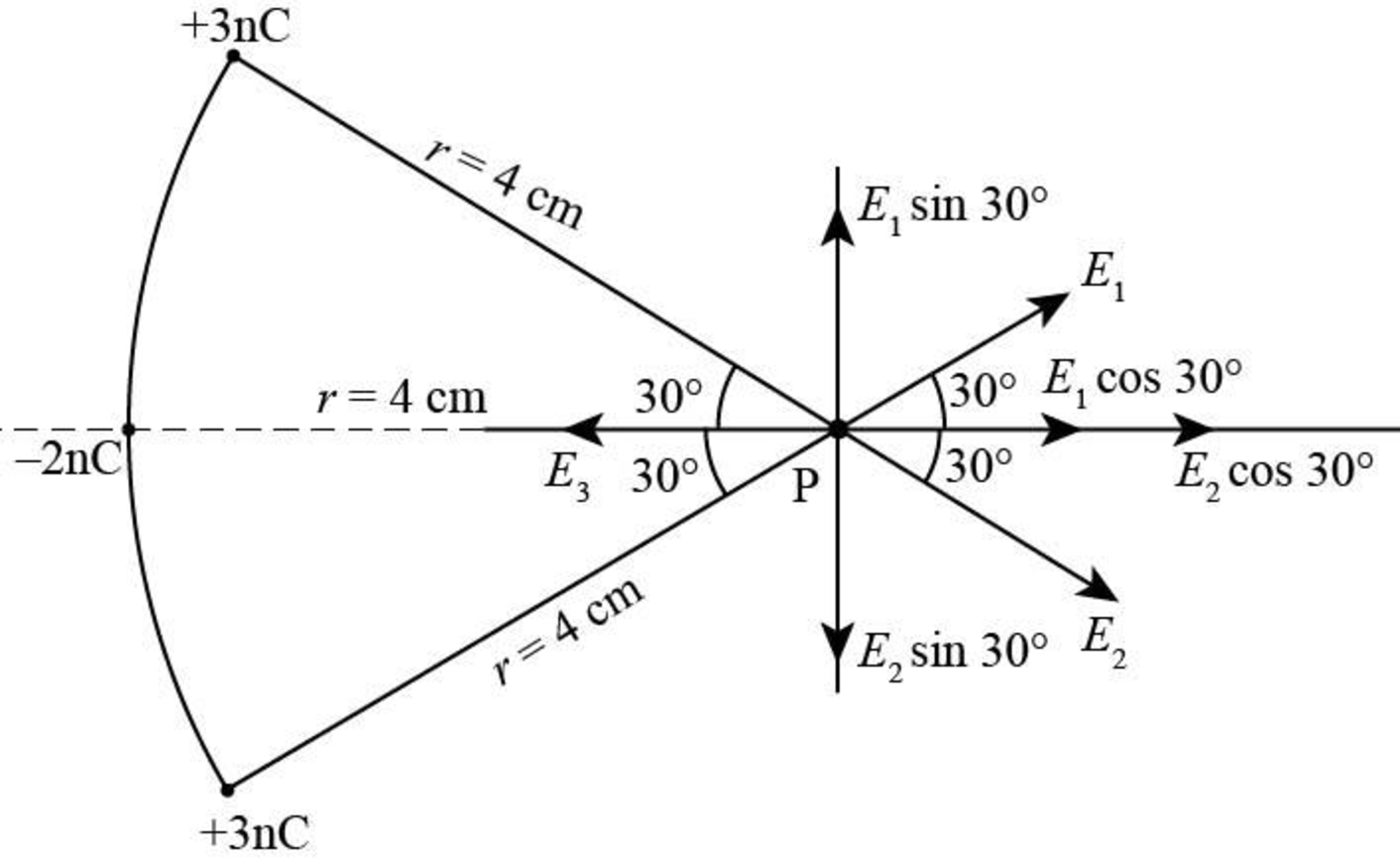
Concept explainers
(a)
The electric field at point
(a)
Answer to Problem 31P
The electric field at point
Explanation of Solution
The net electric field at point

Figure-(1)
Write the expression for the electric field.
Here,
Write the expression for the electric field due to the bottom
Here,
Write the expression for the electric field due to upper
Here,
Write the expression for the electric field due to
Here,
Write an expression to obtain the net electric field at point
Here,
Conclusion:
Substitute
Substitute
Therefore, the electric field at point
(b)
The force at point
(b)
Answer to Problem 31P
The force at point
Explanation of Solution
Write the expression to obtain the force at point
Here,
Conclusion:
Substitute,
Therefore, the force at point
Want to see more full solutions like this?
Chapter 23 Solutions
Physics: for Science.. With Modern. -Update (Looseleaf)
- Three point charges are located on a circular arc as shown in Figure P22.19. (a) What is the total electric field at P, the center of the arc? (b) Find the electric force that would be exerted on a 5.00-nC point charge placed at P. Figure P22.19arrow_forwardA Figure P23.65 shows two identical conducting spheres, each with charge q, suspended from light strings of length L. If the equilibrium angle the strings make with the vertical is , what is the mass m of the spheres? Figure P23.65arrow_forwardA line of positive charge is formed into a semicircle of radius R = 60.0 cm as shown in Figure P23.41. The charge per unit length along the semicircle is given by the expression = 0 cos . The total charge on the semicircle is 12.0 C. Calculate the total total on a charge of 3.00 C placed at the center of curvature P. Figure P23.41arrow_forward
- A Two positively charged particles, each with charge Q, are held at positions (a, 0) and (a, 0) as shown in Figure P23.73. A third positively charged particle with charge q is placed at (0, h). a. Find an expression for the net electric force on the third particle with charge q. b. Show that the two charges Q behave like a single charge 2Q located at the origin when the distance h is much greater than a. Figure P23.73 Problems 73 and 74.arrow_forwardEight small conducting spheres with identical charge q = 2.00 C are placed at the corners of a cube of side d = 0.500 m (Fig. P23.75). What is the total force on the sphere at the origin (sphere A) due to the other seven spheres? Figure P23.75arrow_forwardA uniformly charged rod of length L and total charge Q lies along the x axis as shown in Figure P23.6. (a) Find the components of the electric field at the point P on the y axis a distance d from the origin. (b) What are the approximate values of the field components when d L? Explain why you would expect these results. Figure P23.6arrow_forward
- Three small metallic spheres with identical mass m and identical charge +q are suspended by light strings from the same point (Fig. P23.55). The left-hand and right-hand strings have length L and make an angle with the vertical. What is the value of q in terms of k, g, m, L, and ? Figure P23.55arrow_forwardIn Figure P24.49, a charged particle of mass m = 4.00 g and charge q = 0.250 C is suspended in static equilibrium at the end of an insulating thread that hangs from a very long, charged, thin rod. The thread is 12.0 cm long and makes an angle of 35.0 with the vertical. Determine the linear charge density of the rod. FIGURE P24.49arrow_forwardThree identical charges (q = 5.0 C.) lie along a circle of radius 2.0 m at angles of 30, 150, and 270, as shown in Figure P15.33 (page 524). What is the resultant electric field at the center of the circle? Figure P15.33arrow_forward
- A point charge of 4.00 nC is located at (0, 1.00) m. What is the x component of the electric field due to the point charge at (4.00, 2.00) m? (a) 1.15 N/C (b) 0.864 N/C (c) 1.44 N/C (d) 1.15 N/C (e) 0.864 N/Carrow_forwardThree identical charges (q = 5.0 C.) lie along a circle of radius 2.0 m at angles of 30, 150, and 270, as shown in Figure P15.33 (page 524). What is the resultant electric field at the center of the circle? Figure P15.33arrow_forwardA uniformly charged insulating rod of length 14.0 cm is bent into the shape of a semicircle as shown in Figure P23.45. The rod has a total charge of 7.50 C. Find (a) the magnitude and (b) the direction of the electric field at O, the center of the semicircle.arrow_forward
 Physics for Scientists and Engineers with Modern ...PhysicsISBN:9781337553292Author:Raymond A. Serway, John W. JewettPublisher:Cengage Learning
Physics for Scientists and Engineers with Modern ...PhysicsISBN:9781337553292Author:Raymond A. Serway, John W. JewettPublisher:Cengage Learning College PhysicsPhysicsISBN:9781305952300Author:Raymond A. Serway, Chris VuillePublisher:Cengage Learning
College PhysicsPhysicsISBN:9781305952300Author:Raymond A. Serway, Chris VuillePublisher:Cengage Learning Physics for Scientists and EngineersPhysicsISBN:9781337553278Author:Raymond A. Serway, John W. JewettPublisher:Cengage Learning
Physics for Scientists and EngineersPhysicsISBN:9781337553278Author:Raymond A. Serway, John W. JewettPublisher:Cengage Learning Principles of Physics: A Calculus-Based TextPhysicsISBN:9781133104261Author:Raymond A. Serway, John W. JewettPublisher:Cengage Learning
Principles of Physics: A Calculus-Based TextPhysicsISBN:9781133104261Author:Raymond A. Serway, John W. JewettPublisher:Cengage Learning College PhysicsPhysicsISBN:9781285737027Author:Raymond A. Serway, Chris VuillePublisher:Cengage Learning
College PhysicsPhysicsISBN:9781285737027Author:Raymond A. Serway, Chris VuillePublisher:Cengage Learning Physics for Scientists and Engineers: Foundations...PhysicsISBN:9781133939146Author:Katz, Debora M.Publisher:Cengage Learning
Physics for Scientists and Engineers: Foundations...PhysicsISBN:9781133939146Author:Katz, Debora M.Publisher:Cengage Learning





